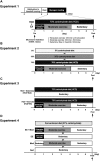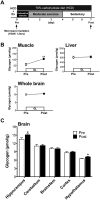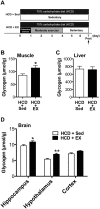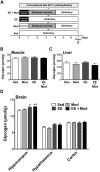Hyper-hippocampal glycogen induced by glycogen loading with exhaustive exercise
- PMID: 29352196
- PMCID: PMC5775355
- DOI: 10.1038/s41598-018-19445-4
Hyper-hippocampal glycogen induced by glycogen loading with exhaustive exercise
Abstract
Glycogen loading (GL), a well-known type of sports conditioning, in combination with exercise and a high carbohydrate diet (HCD) for 1 week enhances individual endurance capacity through muscle glycogen supercompensation. This exercise-diet combination is necessary for successful GL. Glycogen in the brain contributes to hippocampus-related memory functions and endurance capacity. Although the effect of HCD on the brain remains unknown, brain supercompensation occurs following exhaustive exercise (EE), a component of GL. We thus employed a rat model of GL and examined whether GL increases glycogen levels in the brain as well as in muscle, and found that GL increased glycogen levels in the hippocampus and hypothalamus, as well as in muscle. We further explored the essential components of GL (exercise and/or diet conditions) to establish a minimal model of GL focusing on the brain. Exercise, rather than a HCD, was found to be crucial for GL-induced hyper-glycogen in muscle, the hippocampus and the hypothalamus. Moreover, EE was essential for hyper-glycogen only in the hippocampus even without HCD. Here we propose the EE component of GL without HCD as a condition that enhances brain glycogen stores especially in the hippocampus, implicating a physiological strategy to enhance hippocampal functions.
Conflict of interest statement
The authors declare that they have no competing interests.
Figures





Similar articles
-
Brain glycogen supercompensation following exhaustive exercise.J Physiol. 2012 Feb 1;590(3):607-16. doi: 10.1113/jphysiol.2011.217919. Epub 2011 Nov 7. J Physiol. 2012. PMID: 22063629 Free PMC article.
-
Prevention of glycogen supercompensation prolongs the increase in muscle GLUT4 after exercise.Am J Physiol Endocrinol Metab. 2003 Oct;285(4):E729-36. doi: 10.1152/ajpendo.00216.2003. Epub 2003 Jun 10. Am J Physiol Endocrinol Metab. 2003. PMID: 12799316
-
The effect of high-intensity intermittent swimming on post-exercise glycogen supercompensation in rat skeletal muscle.J Physiol Sci. 2012 Jan;62(1):1-9. doi: 10.1007/s12576-011-0170-y. Epub 2011 Oct 8. J Physiol Sci. 2012. PMID: 21983750 Free PMC article.
-
Carbohydrate-loading and exercise performance. An update.Sports Med. 1997 Aug;24(2):73-81. doi: 10.2165/00007256-199724020-00001. Sports Med. 1997. PMID: 9291549 Review.
-
Restoration of Muscle Glycogen and Functional Capacity: Role of Post-Exercise Carbohydrate and Protein Co-Ingestion.Nutrients. 2018 Feb 23;10(2):253. doi: 10.3390/nu10020253. Nutrients. 2018. PMID: 29473893 Free PMC article. Review.
Cited by
-
Exercise-brain interaction of neuroplasticity: empirical evidence in the rodent adaptation.Phys Act Nutr. 2022 Dec;26(4):1-4. doi: 10.20463/pan.2022.0018. Epub 2022 Dec 31. Phys Act Nutr. 2022. PMID: 36775645 Free PMC article.
-
Glucose-Sparing Action of Ketones Boosts Functions Exclusive to Glucose in the Brain.eNeuro. 2020 Nov 9;7(6):ENEURO.0303-20.2020. doi: 10.1523/ENEURO.0303-20.2020. Print 2020 Nov-Dec. eNeuro. 2020. PMID: 33168619 Free PMC article.
-
Astrocytes of the hippocampus and responses to periprandial neuroendocrine hormones.Physiol Behav. 2025 Jun 1;295:114913. doi: 10.1016/j.physbeh.2025.114913. Epub 2025 Apr 8. Physiol Behav. 2025. PMID: 40209869 Review.
-
Tyrosine as a Mechanistic-Based Biomarker for Brain Glycogen Decrease and Supercompensation With Endurance Exercise in Rats: A Metabolomics Study of Plasma.Front Neurosci. 2019 Mar 19;13:200. doi: 10.3389/fnins.2019.00200. eCollection 2019. Front Neurosci. 2019. PMID: 30941004 Free PMC article.
-
Time-dependent changes in hippocampal and striatal glycogen long after maze training in male rats.Neurobiol Learn Mem. 2021 Nov;185:107537. doi: 10.1016/j.nlm.2021.107537. Epub 2021 Oct 8. Neurobiol Learn Mem. 2021. PMID: 34634434 Free PMC article.
References
-
- Ahlborg B, Bergstrom J, Ekelund L, Hultman E. Muscle glycogen and msucle electrolytes during prolonged phyiscal exercise. Acta Physiol. Scand. 1967;70:129–142. doi: 10.1111/j.1748-1716.1967.tb03608.x. - DOI
Publication types
MeSH terms
Substances
LinkOut - more resources
Full Text Sources
Other Literature Sources

